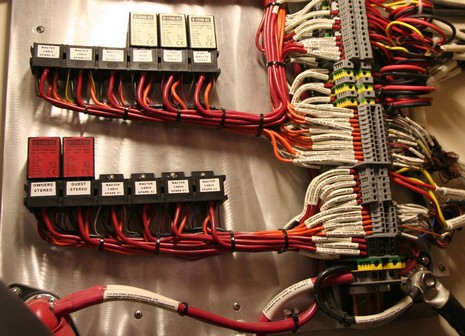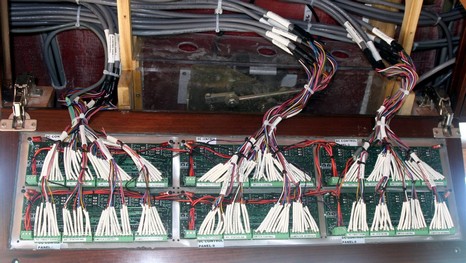Distributed power, no bus, no code

This (bigger here) is one of the DC panels on Electra. What’s unusual is that its modern electronic breaker/switches do not connect to a bus and then to various microprocessor-loaded control panels, like, say, Moritz’s Octoplex (my PMY column in PDF here) and other systems Nigel Calder has covered so well in Professional Boatbuilder.
Instead, Electra’s E.E. owner has had individual wires run from every relay to control panels he designed and built himself. That’s the back of several below, and bigger here. My Nov. PMY column will explain some of his thinking but suffice it to say that while he did not want a common bus or lots of software involved in his critical systems, he did want total control from the pilot house and lots of automation.
George Wallner does allow that his style of distributed power required an wicked amount of wiring, and you can see in these photos what a remarkably tidy and well-documented job the guys at Lyman-Morse did. There’s a Billy Black picture of the whole pilot house panel array under construction included in the online version of a piece I wrote recently about Lyman-Morse’s rather amazing woodworking department. Please check it out; it’s got nothing to do with electronics but it’s a bit of writing I’m particularly proud of.














What a neat wiring job. WOW. What I would like to get are all those neat little wire labels. Do you know a source for same? Adding them to an existing wiring system probably means doing new connectors unless, they can be added to existing wires with terminals and that would be ideal.
I did some for large cables by printing on paper and sealing them with clear heat shrink, but for the small stuff this seems hardly do able.
No service loops on most of this wiring either.
jef
sv shiva
I’m looking at those cirucuit boards and wondering what a stray bolt of lightning would do to the whole system. Would this type of setup limit where you could safely travel because of electrical storms?
-Mark
http://GoReads.com
The wire labels were probably done by a Kroy Labeler which produces cool shrink tube with the printing on it. I have one and it’s really neat.
Check it out here:
http://www.graphicproducts.com/labelers/kroy-5100/index.html
Dan
Mark, I’ll ask George Wallner what he’s done for lightning protection (thanks!), but doubt he feels limited to where he can go. He seems to have thoroughly thought out what could go wrong with his systems.
Thanks, Dan, I too have been wondering what made those nifty labels. I see the Kroy has a PC connection, which must help a lot with a boat like Electra. I’d guess that there are over ten thousand cable and wire labels!
I would like to see a picture of the other side of the panel. Squinting at the back, it looks like he has led’s for circut on, breaker tripped and so, as well as on-off switches.
It would also be interesting to see a cost comparison of this arrangement (labor included) with Calder’s “three wire boat”.
Check out the Dymo Labeler with Marine Labels. West sells them. The labels stay on-I tested them in snow, sun, rain-they are great.
Lightning protection on boats is a huge subject that I do not want to get into. Lets just say that there could two types lightning “hits”: Catastrophic direct hit and high surge (caused by a near miss that induces very high currents and voltages into on-board wiring). What happens during a direct hit on a composite boat is anybody’s guess, but not being able to turn on the lights in the head would be my least concern. A high surge hit — by far the most likely occurance — would fry any electrical and electronic systems that did not have adequate surge protection.
Electra’s load switching system incorporates three layers surge protection: each solid state relay/circuit breaker module has its own built in surge protection, all control wiring is ran in shielded cables whose shields are tied to an extenstive low impedance grounding system, and each control panel has its built-in surge protection. Furthermore, the signal that actuates the solid state relay/circuit breaker is generated by a mechanical switch: no intervening electronics that could get fryed. By the way, the solid state relay/circuit breakers are automotive relays: they are very (very) sturdy. And if all that fails, one can simply remove a relay/breaker module and jumper the terminals.
OFF TOPIC
Airmar will release a sailing catamaran-compatible ultrasonic wind instrument, the PB200 in October. It will feature a 3D gyro, GPS and extensive wind data, and will be available with either Nmea 0183 or Nmea 2000 interfaces. Yummy!
Ben et al – a question from a novice. I have read of the ‘3 wire boat’ and think I understand the goals and aims of this type of electrical system. What I am less clear on is the overlap (if any) between the NMEA2000 standard or devices. How do these two systems overlap – or compliment each other? Any help here would be much appreciated.
Regards, Mike
Mike, I’m not completely up on this, but my understanding is that NMEA 2000 can be the control “wire” in a three wire system, but it certainly doesn’t have to be.
N2K/CANbus may be too much complication and expense if the only data passing back and forth is “Turn On/Off” and maybe “Current Load”. Then again, consider what can happen if power info and control is on the same bus with a boat’s navigation and engine data.
A good example, I think, are the off boat security systems that alarm you about various problems and let you control some items like lights and AC from your home or phone. Their complexity and cost will drop mightily once all this stuff lives on a common bus (or buses), while reliability and features improve.